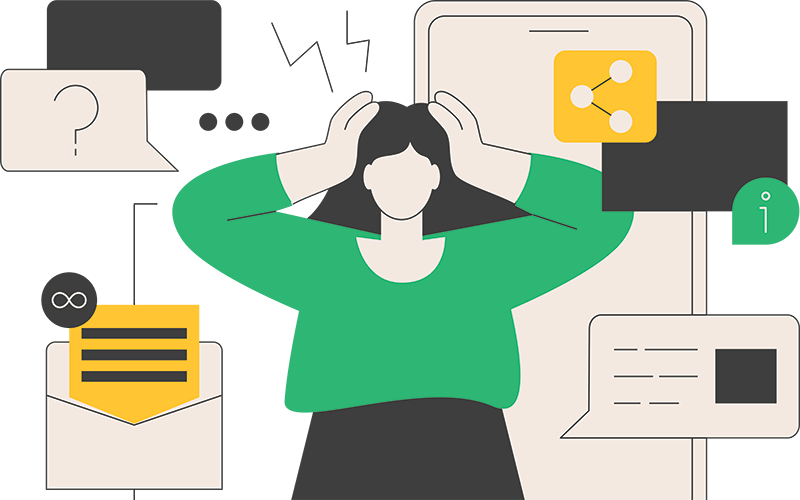Workplace: Ping fatigue

How constant alerts are draining the modern workplace.
Digital communication tools were designed to make life easier and, in many ways, they have. Emails have replaced long, drawn-out phone calls, instant messages (IMs) have taken over sluggish back-and-forth physical meetings, and smartphones have made sure we’re always contactable, no matter where we are. However, these advances in technology come at a price, one we're only just beginning to fully appreciate: ping fatigue.
Ping fatigue is a form of mental exhaustion caused by constant notifications from work-related tools such as email, instant messaging apps, task management systems and calendar reminders. What started as a means of simplifying workflow has now become a potential onslaught of distractions. These relentless chimes, buzzes and dings, designed to keep us connected, can overwhelm employees and nibble away at productivity and well-being with their incessant bombardment. For recruiters, who juggle time-sensitive tasks, managing this digital overload is crucial to stay sharp, efficient and motivated.
The science behind distraction
Notifications may seem like small interruptions, but their impact is far-reaching. Research shows that it takes an average of 23 minutes to refocus after being distracted, according to an article on Workjoy.co. For recruiters, this could mean losing precious time while navigating between tasks like candidate sourcing, client communications and admin work.
The issue isn’t just productivity, it’s also mental health. The constant stream of pings fosters an ‘always-on’ culture, making it hard to disengage, especially in hybrid or remote set-ups. This is particularly taxing for recruiters who often work across global timezones, leaving them vulnerable to burnout.
Productivity vs availability
Part of the problem stems from confusing productivity with availability. Many workplaces have adopted this mindset, which can significantly derail performance. For recruiters, being always ‘reachable’ doesn’t mean they’re effective. In fact, continuous interruptions can dilute the deep focus needed to screen candidates or devise hiring strategies.
Worse still, not all notifications are essential. Without clear guidelines on communication priorities, recruiters risk spending their days reacting to pings instead of executing meaningful work.
Solutions to ping fatigue
Reducing ping fatigue isn’t about an all-out ban on notifications by any means, but rather implementing them in a more tactical fashion, considering both how and when they’re used. This will mean notifications will do the job they were designed to do: help keep employees informed and productive.
Here are the steps that organisations and employees can take to minimise the impact of continual alerts:
- Set boundaries for deep work: Schedule ‘focus time’ by using tools like Microsoft Teams’ ‘do not disturb’ mode. Normalising such practices can empower recruiters to tackle high-value tasks like interviews or creating job adverts without distractions.
- Prioritise channels: Define which communication channels suit different scenarios. For instance, urgent hiring decisions might be discussed on IM (Instant Messaging), while routine updates could wait for email or team meetings.
- Adapt to individual needs: Not everyone responds to notifications in the same way. Some recruiters may thrive in a fast-paced, multi-channel environment, while others might need fewer interruptions. Adjusting communication styles ensures everyone stays productive.
- Foster a results-oriented culture: Shift the focus from immediate responses to achieving outcomes. Whether it’s filling a role quickly or developing a recruitment campaign, the quality of work should outweigh constant availability.
Ping fatigue is rising in workplaces worldwide. While digital tools have revolutionised how we work, they’ve also brought new challenges. If deployed thoughtfully, with a focus on top quality work and wellbeing, recruiters can use these tools to create a healthier and more rewarding environment for all.
Amanda Childs is group HR director at Kyocera.
Key takeaways for recruiters
Prioritise focus time: Allocate uninterrupted periods to concentrate on critical tasks like candidate evaluations or crafting job descriptions. Tools like ‘do not disturb’ can help reduce disruptions.
Clarify communication protocols: Establish when to use IM, email or meetings to streamline interactions. Avoid marking non-urgent emails as ‘high priority’.
Encourage breaks: Step away from screens regularly to refresh and avoid burnout. Even a 5-minute pause between tasks can enhance clarity and focus.
Tailor notifications: Customise settings to limit non-essential pings. Recruiters should mute irrelevant channels or threads that don’t directly impact their roles.
Support individual needs: Team members experience notifications differently. Open discussions about preferences can create a more supportive work environment.
Focus on outcomes, not presence: Measure success by results rather than response times. Recognise that recruiters produce their best work when they can focus deeply, free from constant interruptions.
Image credit | iStock
